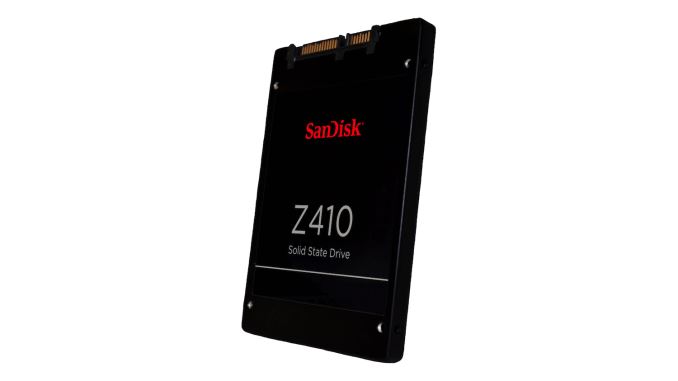SanDisk Announces Z410 Client SSD
by Billy Tallis on April 27, 2016 5:05 PM EST
SanDisk has introduced a new low-end drive to their line of client SSDs targeted at business and OEM customers. The Z410 is positioned closely to Z400s but is not a direct replacement. Instead, the Z410 focuses on offering just the most popular capacities for mainstream PC usage while the Z400s continues to serve other markets with mSATA and M.2 versions and capacities as small as 32GB.
First announced almost a year ago as the first 15nm TLC SSD, the Z400s sought to cut costs in order to break into new parts of the embedded and client PC markets. The Silicon Motion SM2246XT controller it uses is a DRAM-less two or four channel design that limits potential performance and capacity. The SM2246XT also lacks encryption support and LDPC error correction.
The SanDisk Z410 abandons the mSATA and M.2 form factors to focus specifically on 2.5" with capacities from 120GB to 480GB. The only significant performance difference from the Z400s is a substantial increase in sequential write speed, while sequential read speeds are rated slightly lower and random read and write specifications are similar. The Z410 does benefit from a controller upgrade that allows for LDPC error correction and SLC caching, but it seems the latter's impact on write amplification has kept the write endurance ratings from increasing substantially. The three year warranty period on the Z410 is also shorter than the five years offered for the Z400s.
| SanDisk OEM Client SSD Comparison | |||
| Drive | X400 | Z410 | Z400s |
| Capacities | 128GB, 256GB, 512GB, 1TB | 120GB, 240GB, 480GB | 32GB, 64GB, 128GB, 256GB |
| Controller | Marvell 88SS1074 | ? | Silicon Motion SM2246XT |
| Sequential Read | 545 MB/s | 535 MB/s | 546 MB/s |
| Sequential Write | 520 MB/s | 445 MB/s | 342 MB/s |
| Random Read IOPS | 95k | 37k | 37k |
| Random Write IOPS | 75k | 68k | 69k |
| Form Factors | 2.5", M.2 2280 | 2.5" | 2.5", mSATA, M.2 2242, M.2 2280 |
| Encryption | TCG Opal (optional) | None | None |
| Endurance | 72-320 TBW | 40-120TBW | 20-72 TBW |
| Warranty | 5 years | 3 years | 5 years |
The introduction of the Z410 puts SanDisk in the unusual position of having three tiers of TLC NAND-based SATA SSDs. While their consumer-oriented product line still includes the MLC-based Extreme Pro, SanDisk's business/OEM line tops out with the TLC-based X400. The X400 distinguishes itself with clearly higher performance and endurance and the availability of a 1TB capacity, but the Z400s and Z410 are close enough to cause some confusion. The Z410 will probably end up displacing the 128GB and 256GB 2.5" Z400s while the rest of the Z400s line sticks around for the less competitive niches.
Source: SanDisk










35 Comments
View All Comments
DCide - Wednesday, April 27, 2016 - link
Exactly - there are so many cases where SATA SSDs are still a great fit - plus some top PCIe models tend to overheat after a paltry minute or so of constant activity! On top of that, they can be tricky to set up as boot drives. And how many motherboards allow 3 M.2 PCIe drives? And ... and ... and ...beginner99 - Thursday, April 28, 2016 - link
Exactly. Last 5 years it was SATA SSD with OS + HDDs for games and media. Soon ti will be PCIe SSD for OS and SSD for games and media. HDDs still have a niche as backup.bug77 - Thursday, April 28, 2016 - link
As I often say: storage tape drives are with us (sort of), even today. It's unrealistic to think HDDs will go the way of the dodo soon.It doesn't mean I'm not eager to be able to replace my 3.5TB storage with SSD, it means HDDs will most likely carve themselves a niche somewhere.
Michael Bay - Thursday, April 28, 2016 - link
If WD and Seagate are to be believed, we`ll have something approaching 16-20Tb in 2020. Perfect for storing media.SunLord - Wednesday, April 27, 2016 - link
That understandable if your building a new system but upgrading an existing system doesn't always offer the choice of using pci-e storage. While pci-e is nice as a boot/system drive option it's not really necessary for storage drives which sata more then fast enough for be it ssd or hdd for the vast majority of end users.Lolimaster - Wednesday, April 27, 2016 - link
Unless you work moving tons of data or video editing, there's no difference between 500MB/s and 2GB/s.Even with the NVME + pcie the improvement in most important parts (4k random and access time are pretty much unchanged). The next big improvemente for those thing will be 3D-Xpoint.
Notmyusualid - Thursday, April 28, 2016 - link
Come on, SATA ain't going away any time soon.There are many of us with systems unable to accept a PCIe-based drive, like myself.
And otherwise my system if perfect, so I ain't gonna change it to get faster storage.
But my next laptop will certainly support it....
damianrobertjones - Thursday, April 28, 2016 - link
I run a few VMs on a nice 850 SSD and, one of them, has Videostudio installed. I have no issues.Samus - Thursday, April 28, 2016 - link
These are good for the rust spinner upgrades, older laptops, kiosks, and refurbs. You wouldn't but an X or Z series Sandisk in a new PC, there are clearly better drives available for pennies more.I am still avoiding this TLC gravy train like the plague. The drives aren't much cheaper and the cons are ridiculous.
maofthun - Wednesday, April 27, 2016 - link
I thought the Z400s is MLC, not TLC